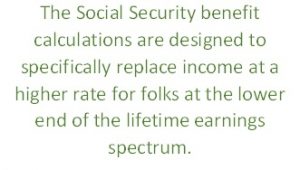
Photo credit: jb
There’s at least one circumstance in the Social Security retirement benefits world where it seems you can have your cake and eat it too. For whatever reason, this one has completely slipped past me up to this point, but I assure you, it’s legitimate and a very real part of Social Security’s rules.
Not long ago, I was looking over some information on Social Security audits (Hey, some people collect stamps, I read audits. Sue me!), when I came across an audit that caught my eye. This particular audit, done by the Office of the Inspector General of the Social Security Administration, was titled Social Security Beneficiaries Financial Advantaged by Electing to Convert from Disability Benefits to Reduced Retirement Benefits. Naturally with a seductive title like that, I had to know more!
The audit explains how certain Social Security disability recipients may achieve an advantage if they make a change from disability benefits to retirement benefits, at some point at or after age 62. This might work in your favor, for example, if you were on Social Security disability benefits and you had a work opportunity available to you. The restrictions on working while collecting disability are pretty harsh, especially when compared to the restrictions on working when you’re receiving Social Security retirement benefits.
While on disability, the Substantial Gainful Activity rule only allows you to earn $1,310 in a month. If you earn more than that amount, your benefit will cease completely, and you’ll need to request a reinstatement of benefits if your income falls below that level in the future (and you’re still disabled).
On the other hand, your earnings while receiving Social Security retirement benefits become limited once you’ve earned $18,960 in a year (works out to $1,580/month), so you’ve got a bit more headroom to work with. Plus, when your income goes over the $18,960 limit, your retirement benefit doesn’t completely cease – for every $2 over the limit, $1 in benefits are withheld. Aaaannnnddd – you get credit for those withheld months later when you reach Full Retirement Age.
So right there, you’ve got two advantages when you switch over from disability benefits to retirement benefits, if you happen to be over age 62.
- Higher monthly earnings limit (it’s actually an annual limit, so each month of overage might be mitigated by a lower month in the same year)
- Going over the limit only reduces your benefit, instead of eliminating the benefit, as with disability.
(Of course, once you’re at FRA your disability benefit automatically switches over to retirement benefits, so that’s not a factor here.)
When you reach Full Retirement Age, if you’ve had any months of benefits withheld because your earnings were above the limit, these months are removed from your early retirement factor, thus increasing your future benefit amount.
For example, if you started benefits at age 62 and your FRA was 67, this means your initial reduction factor calculates to 30% (more details on reductions here). Let’s say your unreduced benefit (your PIA) is $2,000. By starting benefits at age 62, it is reduced by 30% to $1,400/month. If you earned too much over the years between age 62 and your FRA and subsequently 10 months’ worth of your benefits were withheld, this means that at FRA, your benefit is recalculated as if you had filed at the age of 62 years and 10 months. This results in a new benefit reduction of 25.83%. So your new benefit from here forward is $1,483.
But the real kicker is what happens at Full Retirement Age when you were originally entitled to disability benefits.
What happens at Full Retirement Age?
In a curious twist to the rules – if you fit the circumstances described within the audit – that is:
- You are currently receiving Social Security Disability benefits
- You are at or older than age 62
- You are otherwise eligible for Social Security Retirement benefits
If you switch over and begin receiving Social Security Retirement benefits while you’re still entitled to the Disability benefit, of course your Social Security Retirement benefit will be reduced from your Primary Insurance Amount since you started benefits prior to Full Retirement Age.
BUT! When you reach Full Retirement Age, when under normal circumstances your benefit might be recalculated to add back those months where your benefit was withheld due to exceeding the earnings limit – another factor is added back as well.
If you were also entitled to Disability benefits at the same time as when you were receiving the Retirement benefits prior to Full Retirement Age, every month that you were entitled to Disability benefits is added back to your record as well.
In other words, if you were otherwise eligible and were originally entitled to the disability benefit but you switched over to a reduced Retirement benefit, for every month that you continued to be eligible for the disability benefit while under Full Retirement Age you will get a credit month added to your record.
So let’s say you’re receiving disability benefits, and you’re 63 years old. Your FRA is 67. But you have an opportunity to take on a job that will pay just over the Substantial Gainful Activity amount. It’s a job that you can do, even in your disabled condition. So you switch over to Retirement benefits, although this will result in a lower benefit (by 25% at this point), but you won’t have the onerous SGA rule hanging over your head.
When you reach FRA, assuming that you have continued to be otherwise eligible for the disability benefit throughout the intervening 4 years, your Social Security retirement benefit will be increased to equal your Primary Insurance Amount. That’s right – no reduction for the early filing!
If you want to dig into the details, you can find out all about this particular wrinkle in the rules by looking at the law behind the Social Security Act – in particular, § 402(q)(7)(F) – it takes some digging and reading/re-reading (it’s the Social Security Act, after all) but it’s well worth the effort to understand this odd but advantageous rule.
While you’re at it, if you find something more in 402(q) that makes your eyes pop, let me know! I’m always interested in picking up new tidbits.














 During your career you may have worked for a governmental agency or a foreign employer where there was no Social Security tax withheld from your earnings (Job A). At the same time or at some other point, you may also have worked in a job that was covered by Social Security (Job B). The end result is that now you’re ready to retire, and you will collect a pension from Job A, and you’re also eligible to collect Social Security benefits based on Job B. But the Social Security benefits are being reduced because of something called WEP –
During your career you may have worked for a governmental agency or a foreign employer where there was no Social Security tax withheld from your earnings (Job A). At the same time or at some other point, you may also have worked in a job that was covered by Social Security (Job B). The end result is that now you’re ready to retire, and you will collect a pension from Job A, and you’re also eligible to collect Social Security benefits based on Job B. But the Social Security benefits are being reduced because of something called WEP – 





 Sterling Raskie, MSFS, CFP®, ChFC®
Sterling Raskie, MSFS, CFP®, ChFC® The latest in our Owner’s Manual series, A 401(k) Owner’s Manual, was published in January 2020 and is available on
The latest in our Owner’s Manual series, A 401(k) Owner’s Manual, was published in January 2020 and is available on  A Medicare Owner’s Manual, is updated with 2020 facts and figures. This manual is available on
A Medicare Owner’s Manual, is updated with 2020 facts and figures. This manual is available on  Social Security for the Suddenly Single can be found on Amazon at
Social Security for the Suddenly Single can be found on Amazon at  Sterling’s first book, Lose Weight Save Money, can be
Sterling’s first book, Lose Weight Save Money, can be  An IRA Owner’s Manual, 2nd Edition is available for purchase on Amazon. Click the link to choose the
An IRA Owner’s Manual, 2nd Edition is available for purchase on Amazon. Click the link to choose the  Jim’s book – A Social Security Owner’s Manual, is now available on Amazon. Click this link for the
Jim’s book – A Social Security Owner’s Manual, is now available on Amazon. Click this link for the  And if you’ve come here to learn about queuing waterfowl, I apologize for the confusion. You may want to discuss your question with Lester, my loyal watchduck and self-proclaimed “advisor’s advisor”.
And if you’ve come here to learn about queuing waterfowl, I apologize for the confusion. You may want to discuss your question with Lester, my loyal watchduck and self-proclaimed “advisor’s advisor”.